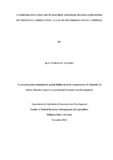Please use this identifier to cite or link to this item:
https://cris.library.msu.ac.zw//handle/11408/536Full metadata record
| DC Field | Value | Language |
|---|---|---|
| dc.contributor.author | Hluyo, Beauty Nyasha | - |
| dc.date.accessioned | 2015-02-23T14:49:22Z | - |
| dc.date.available | 2015-02-23T14:49:22Z | - |
| dc.date.issued | 2014 | - |
| dc.identifier.uri | http://hdl.handle.net/11408/536 | - |
| dc.description.abstract | For the past decades Southdown estate in Zimbabwe employed manual tea harvesting method, due to labour shortages and increase in labour costs tea harvesting became expensive. Although the estate adopted machine harvesting method in a quest to resolve imminent financial problems faced at Southdown the costs kept escalating. Therefore this study was undertaken to compare the two harvesting methods (hand harvesting method and machine harvesting method) in order to evaluate the costs and benefits for the two harvesting methods in tea production. In order to answer the first objective which was assessing the financial viability of machine versus hand picking in tea production a gross margin was used. The second objective was to compare costs and benefits of hand picking versus machine harvesting method and a cost and benefit analysis was conducted to attain the second objective. The results revealed that machine harvesting method is more viable than hand picking because it yielded a higher gross margin of US $17639.36 as compared to hand harvesting method which yielded a gross margin of US $9534.34. The second objective was to compare the costs and benefits of machine and hand picking harvesting methods. NPV, IRR and BCR were used as decision criteria. NPV for machine harvesting method was US$28603.55 and US$21106.37 for hand harvesting method. IRR for machine harvesting method was 46% and for hand harvesting method was 34%. BCR for machine was 2.79 and for hand harvesting method was 2.19. Hence, the researcher concluded that machine harvesting is more viable. A sensitivity analysis to changes in discount rate was conducted and the results show that NPV and BCR for both harvesting methods are viable even when discount rate is increased to 33% and 44%. IRR for both harvesting methods was not viable when discount rate was increased to 44%. From the results above it shows that machine harvesting method is more viable than hand harvesting method. Therefore the study recommends Southdown estate to employ mechanical harvesting method since it is more cost-effective than hand harvesting method. | en_US |
| dc.language.iso | en | en_US |
| dc.publisher | Midlands State University | en_US |
| dc.subject | Harvesting | en_US |
| dc.subject | Tea production | en_US |
| dc.title | A comparative anaysis of machine and hand picking harvesting method in tea production: a case of Southdown in Chipinge | en_US |
| item.fulltext | With Fulltext | - |
| item.grantfulltext | open | - |
| item.languageiso639-1 | en | - |
| Appears in Collections: | Bsc Agricultural Economics And Development Honours Degree | |
Files in This Item:
| File | Description | Size | Format | |
|---|---|---|---|---|
| BEAUTY final dissertation n corrections 333.pdf | 875.52 kB | Adobe PDF |  View/Open |
Page view(s)
286
checked on Nov 23, 2025
Download(s)
312
checked on Nov 23, 2025
Google ScholarTM
Check
Items in MSUIR are protected by copyright, with all rights reserved, unless otherwise indicated.



